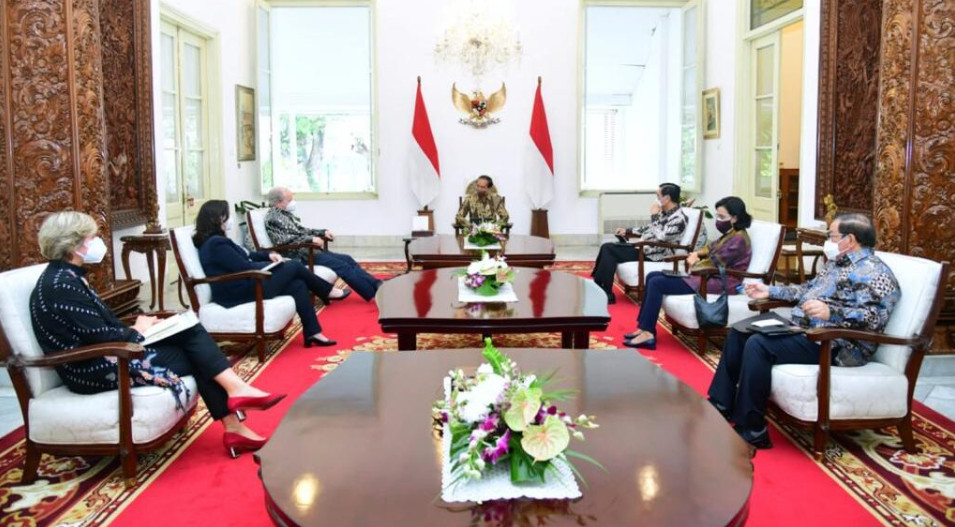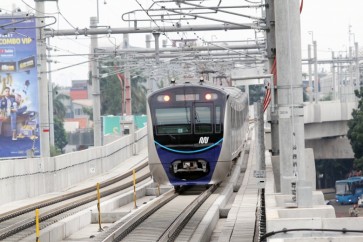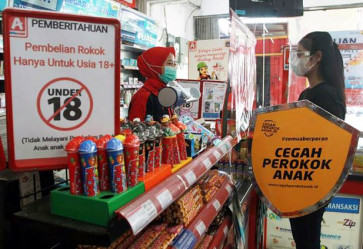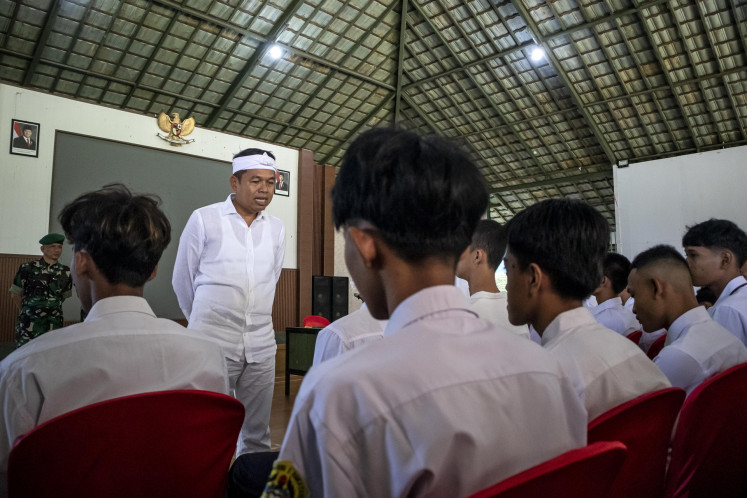World Bank warns RI of downside risks to GDP growth
Amid rising inflation and global interest rates, the World Bank released a downside growth scenario where Indonesia’s GDP growth would fall short of the government’s target in both 2022 and 2023.
Change text size
Gift Premium Articles
to Anyone

T
he World Bank warns that Indonesia’s GDP growth this year and next could fall far short of the government’s targets should inflationary pressure and therefore global interest rates rise.
In a report published on Wednesday, Indonesia Economic Prospects June 2022, the World Bank maintains its baseline scenario for the country’s economic growth at 5.1 percent in 2022 and 5.3 percent in 2023 but warns that it could be as low as 4.6 and 4.7 percent, respectively in a downside scenario.
The report contains no upside scenario.
The government projects 2022 growth at 4.8 to 5.5 percent and 2023 growth at 5.3 to 5.9 percent, while the Organization for Economic and Cooperation Development (OECD) sees domestic growth this year at 4.7 percent.
Even in the downside scenario, Indonesia would fare better than the emerging economy average estimate of 3.4 percent in 2022 and the global average of 3 percent in 2023.
“Given the global conditions […] a synchronized and broad-based slowdown in global growth is bound to also impact Indonesia,” World Bank Indonesia and Timor-Leste lead economist Habib Rab told reporters on Wednesday.
Read also: World Bank sees Indonesia’s GDP rebound to 5.1 percent this year
Sectors aside from resource-exporting ones, such as light and heavy manufacturing, as well as contact-intensive sectors, such as hospitality, services, retail and wholesale trade, are told to brace for a heavy slowdown in this scenario due to higher prices.
Should prices increase as much as assumed under this scenario, consumer confidence and demand would drop significantly, he noted.
“That includes steel manufacturing and other basic metals, which really went up thanks to the global rebound in 2021, particularly in China and the United States," Rab continued.
Private consumption, which accounts for the majority of GDP spending in Indonesia, would face a significant slowdown in this scenario, he said, as inflation would erode purchasing power.
Next on the hit list would be investment, as monetary normalization in developed countries would tighten external financing, leading to a slowdown in capital inflows and foreign direct investments.
"As demand and inflation continue to increase, Bank Indonesia may eventually start to normalize the policy rate [7-Day Reverse Repo Rate], which together with government calls on financial sector liquidity, might mean that the cost of private financing would likely rise," Rab added.
The institution’s economists stated that the downside scenario, where inflationary pressure is higher than under the baseline scenario, would force the government to prioritize subsidy expansion in response to high energy prices rather than pro-growth fiscal spending.
The World Bank economists expect crude oil to average US$100 per barrel in 2022.
The government-debt-to-GDP ratio is expected to reach 42.9 percent in 2022, slightly higher than the 39.09 percent reported in April, but much lower than the 60 percent limit mandated by law.
In May, the House of Representatives approved around Rp 291 trillion ($19 billion) in additional budget spending on energy subsidies and compensation, bringing the total expenditure for those two items to Rp 443 trillion, as the Indonesian Crude Price (ICP) increased from an initial assumption of $63 to $100 per barrel.
“The bigger impact will be on the balance sheet on Pertamina and PLN, because they are selling fuel and electricity at prices that are below their cost. [The] implicit subsidy provided through them could increase from around 0.7 percent of GDP in 2021 to around 1.5 percent of GDP in 2022. And that compensation for selling at below-market costs is usually done in later years," he added.
Read also: Govt seeks vast energy subsidy hike
Other than a shift in government spending, the report also warns that export volumes could drop as overseas demand decreased due to rising global interest rates, which would also affect borrowing costs and investment in trade partners.
Even then, the World Bank still estimates that this year’s current account would book a surplus of 0.2 percent of GDP thanks to the recently adopted Tax Harmonization Law (HPP) and higher export revenues due to price windfalls.
"But one thing to quickly note is that we are not projecting a recession, unlike in some other countries. In the low-case scenario, the economy would still grow at 4.6 percent. It is just that some of these sectors might grow somewhat slower," Rab continued.
In the face of these challenges, the World Bank recommends that the government gradually pass through higher energy prices to consumers and switch to targeted subsidies, as World Bank estimates show that current oil subsidies are 42 to 73 percent consumed by middle- and upper-class consumers.
If untargeted subsidies, which are estimated to amount to 1.1 percent of GDP, were replaced by targeted social transfers to the tune of 0.5 percent of GDP, then the state budget would have much more leeway to bolster pro-growth spending.
"A lot of structural reforms that can help [bring about] a reallocation of resources to more productive ends would help to sustain growth in the longer term and mitigate some of the impacts of these downside scenarios," he said.
Deputy Finance Minister Suahasil Nazara said on Tuesday that domestic economic growth was heavily influenced by growth in the United States and China, as Indonesia’s exports and financial markets were interconnected with the two countries.
As a result, he stated, domestic inflation and interest rates would have to take global conditions into account, yet he expressed optimism that 2023 GDP growth would still be in the target range of 5.3 to 5.9 percent.
“We continue to monitor global developments […] and we are trying to understand the situation in a detailed manner,” Suahasil told reporters.
Indonesian Chamber of Commerce and Industry (KADIN) deputy chairperson Shinta Widjaja Kamdani said on Tuesday that businesses would do their best to exceed the 5 percent GDP target, as they still saw a lot of potential for the rest of the year.
“If the effects of subsidies and energy prices on the competitiveness of the business climate are not taken into account, we will be unable to maintain our national industrial competitiveness vis-à-vis imports and unable to attract investment,” she said in a written message to The Jakarta Post.









